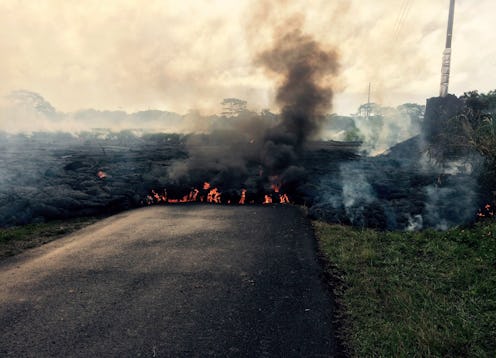
After literally hundreds of earthquakes rattled the islands over the course of just a few days, watching the video of Hawaii's Kilauea Volcano erupting feels surreal. If you don't live in Hawaii, full-on volcanic eruptions seem otherworldly. They might make you think, for instance, about the ancient city of Pompeii. But, as Thursday's eruption reminded everyone, active volcanoes are still a very real threat — and they're not something to mess with.
Though injuries have not yet been reported, a subdivision called Leilani Estates, which is located near the volcano on the Big Island, has been evacuated. According to Honolulu's local CNN affiliate KHON, the eruption didn't just come out of nowhere. Residents of the Big Island's Puna district had been preparing for it since small-scale earthquakes started happening on Monday. The earthquakes began after a crater in a volcanic cone located in the eastern rift of Kilauea collapsed. Hawaii Volcanoes National Park's superintendent Cindy Orlando told KHON:
The recent eruption changes and increased seismicity around the East Rift Zone and Pu‘u ‘Ō‘ō vent may threaten land and the community outside the park. The partial closure in the park is necessary to prevent unsafe travel onto lands under the jurisdiction of Hawai‘i County and to keep people safe. Most of the park, which is 333,308 acres in size, remains open.
As the United States Geological Survey's records suggest, Thursday was definitely not the first time Kilauea Volcano erupted. In fact, eruptions have been happening somewhat regularly over the past three decades or so. The government agency noted that scientists have broken up the eruptions since 1983 into 61 different "episodes." Its website lays out some fascinating statistics about just how much the continuous activity has altered the landscape in the national park:
By the end of 2016, lava flows had covered 144 km2 (55.6 mi2), erupted about 4.4 km3 (1.1 mi3) of lava, and had added 179 hectares (443 acres) of new land to Kīlauea's southeastern shore. Lava flows also destroyed 215 structures and buried 14.3 km (8.9 mi) of highway with lava as thick as 35 m (115 ft).
That 1983 eruption spewed lava an unbelievable 1,500 feet into the sky, as CBS News reported. The earthquakes that led up to the Thursday eruption are being compared to those preceding one that happened prior to 1983, however. Hawaiian Volcano Observatory geophysicist Jim Kauahikaua told Hawaii News Now that similar quakes were the catalyst for an eruption that occurred back in 1955 and lasted three months. Nearly 4,000 acres of land were doused in lava when all was said and done.
So, although news that Kilauea Volcano is erupting might sound shocking, it's part of the territory. And that's exactly why it's considered one of the world's most active volcanoes, according to the United States Geological Survey. Some Puna residents' reactions to the possibility of Kilauea erupting show they've accepted such events are completely out of their control.
"If Pele comes, Pele comes," Puna resident Curt Redman told Hawaii News Now, referring to the goddess of fire and volcanoes. "We have to do what we got to do, but... now we're kind of crossing our fingers to see what Pele might do next."
Kilauea is by far not the only active volcano in the United States. In fact, according to the American Geosciences Institute, there are over 160 active volcanoes in America. Most of them, the institute's website notes, are in Alaska or Hawaii. And the United States might not be properly prepared for any of them to erupt, according to a February 2017 report from The Atlantic. Estelle Chaussard, an assistant professor of geophysics and volcanology at State University of New York, told the outlet that assuming volcanic eruptions are rare is actually "very dangerous, because most of our volcanoes are not as intensively monitored as we think they are or as they should be.” As Kilauea continues to erupt, this point hits home pretty hard.